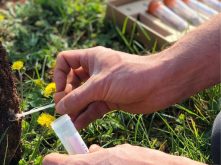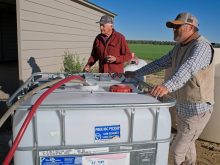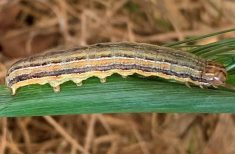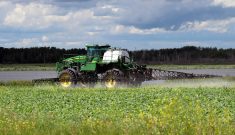Following up on last issue’s roundup of product launches and label expansions in the cereal crop input market, here we’ve put together a quick list of new and/or improved pulse crop inputs that were announced in our earshot during the past year, including several due out for the coming growing season.
Again, if we’ve inadvertently missed something or someone, let us know. And as always, be sure to read and follow label directions.
Read Also

Cancer agency reclassifies another herbicide ‘probably carcinogenic’
The WHO’s cancer research agency has now put atrazine, a herbicide well known to corn growers, in the same potential-hazard category where the agency put glyphosate.
Authority Strike herbicide
FMC Canada this month launched Authority Strike, a combination of two Group 14 actives, carfentrazone and sulfentrazone, registered for pre-seeding or pre-emergence use in pea, chickpea, fababean, soybean, mustard, wheat (spring and durum), flax and sunflower crops. The company describes the product as “an especially strong tool for kochia, allowing growers to target the weed with a fast burnoff followed by extended control to keep flushing kochia at bay.”
FMC says the product is also effective on other broadleaf weeds such as lamb’s-quarters, pigweed, Russian thistle, wild buckwheat and waterhemp, and can also be tank-mixed with glyphosate.
AvadexMicroActiv herbicide
Gowan announced in September it had picked up a label expansion for Avadex MicroActiv, for the control of wild oats in lentil and chickpea crops.
“Already a cornerstone wild oat management solution for spring and durum wheat, barley, canola, canary seed, mustards, peas and flax, this addition provides more growers the means to combat wild oat populations resistant to Group 1 and 2 modes of action in select fields,” Dale Ziprick, Gowan’s product manager for Avadex brands, said in a release at the time.
Davai A Plus herbicide
Adama’s Davai A Plus, launched last January, is advertised as a broad-spectrum herbicide combining its Group 2 product Davai 80 SL (imazamox) with a Group 1, Arrow All In (clethodim). Davai A Plus is registered for use in imidazolinone-tolerant (Clearfield) lentils as well as in peas, dry beans and soybeans.
“This new registration brings product choice to growers for a crop that historically had none,” Cornie Thiessen, Adama Canada’s general manager, said in a release at the time.
Delaro Complete fungicide
Released previously in Eastern Canada, Delaro Complete has since picked up registration for use in Western Canada on pulse crops including peas, chickpeas and lentils. The Bayer CropScience product combines actives from Groups 3, 7 and 11, which the company said will provide “advanced control of the most important pulse crop diseases while delivering a vital tool for lentil and chickpea growers in combatting increasing pressures of anthracnose and ascochyta.”
By adding fluopyram, a Group 7 active, to the Delaro brand, Bayer said the new offering “enhances white and grey mould control performance and offers extra residual protection.”
In its announcement last July, Bayer said Delaro Complete “should be applied preventively at first flower or the first signs of disease” for best results.
Maxentis fungicide
Adama said earlier this month its Maxentis fungicide, for use in lentil, pea, canola and soybean crops, is the first in Canada to combine prothioconazole (Group 3) and azoxystrobin (Group 11) into “one easy-to-use product.”
Andre Barabach, Adama Canada’s fungicide product manager, said Maxentis allows growers “to spray faster and more efficiently across multiple crops, and across multiple stages of plant growth and disease development.”
Adama said Maxentis also includes its Asorbital 2 Formulation Technology, which creates “systemic and translaminar movement (and) allows the fungicide to spread across the entire plant, even when sprayed on top of dense canopies, creating longer-lasting and more complete coverage.”
RevyPro fungicide
BASF launched RevyPro in May as “a new standard for disease management in pulses for western Canadian growers,” saying reports of disease resistance in pulse crops beginning in 2019 caused “a pivot” in the company’s approach.
The product is the first pulse fungicide in Canada using BASF’s Revysol, which is based on a Group 3 fungicide, mefentrifluconazole. RevyPro combines that active with another Group 3 azole fungicide, prothioconazole. Revysol’s mode of action “allows it to bind to the target site—the pathogen—more powerfully than conventional triazole fungicides,” BASF says.
RevyPro, whose listed crops include peas, lentils, chickpeas and various dry beans, is registered for control of anthracnose on lentils and dry beans; ascochyta blight; mycosphaerella blight on field peas; and white mould on all crops except dry beans. It’s also registered for suppression of grey mold and chocolate spot; powdery mildew; and, on dry beans, white mould.
Select Plus herbicide
UPL in July announced it would launch Select Plus, which combines a “fop” and “dim” product from the Group 1 family of ACCase inhibitors. It puts UPL’s Select brand of clethodim together with quizaolfop-p-ethyl for “improved tank mixing capability” in post-emergent control of various annual and perennial weeds in canola, pulses and soybeans.
Adding quizaolfop-p-ethyl “ensures Select Plus can improve growers’ ability to tackle hard-to-kill, post-emergent annual and perennial grasses — stopping the weeds in their tracks,” Jon Gough, UPL’s Canada portfolio marketing lead, said in a release at the time.
Vibrance Total fungicide
Available for the 2024 season, Vibrance Total is billed as the only pulse seed treatment on the market with the active ingredient picarbutrazox, providing “highly effective” protection against 13 different pythium species found in soils in Western Canada, Syngenta Canada said in September.
The product, which also includes thiabendazole, sedaxane, metalaxyl-M and fludioxonil on its list of actives, represents five different fungicide groups in total. The product is listed for control of various seed-borne and soil-borne diseases on beans, lentils, lupins, fava beans, peas and chickpeas.
Zetigo PRM fungicide
Corteva in March introduced a novel Group 21 active fungicide, Adavelt, billed as the “first broad-spectrum picolinamide fungicide for use against ascomycota pathogens in major crops grown worldwide.”
The first Adavelt product out of the gate in Canada is Zetigo PRM, which, as our Mark Halsall reported at the time, was made available for the 2023 season for use against anthracnose in lentils. Its current label also covers it for suppression of blackleg in canola.
Based on UK-2A, a naturally occurring compound found in soil bacteria, Corteva had previously launched the picolinamide family with fenpicoxamid (Inatreq), a cereal crop fungicide.
Adavelt’s active ingredient, florylpicoxamid, has “a novel target site of action in many crops with no cross-resistance to other modes of action,” thus can be used in integrated pest management programs as a resistance management tool. Zetigo also includes pyraclostrobin (Group 11).















